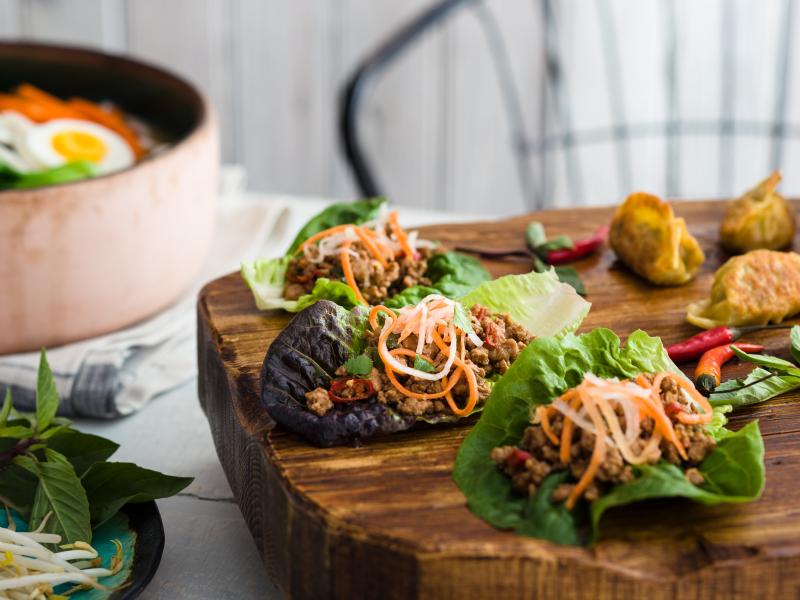
Asian Lettuce Wraps
Macros / Serving Size
Protein 25g | Fat 10g | Carbs 233g
% Calories of Macros / Serving Size
Calories 281 | Protein 36% | Fat 33% | Carbs 31%
Nutrients / Serving Size
Fiber 4g | Sodium 628mg | Sat. Fat 3g
Ingredients (Servings 4)
- 1 tsp. fresh grated ginger or ½ tsp. ground ginger
- 1 tsp. mince garlic or ½ tsp. garlic powder
- 2 tbsp. low sodium soy sauce
- 2 tbsp. Hoisin sauce
- 1 cup instant brown rice
- 8 oz. canned bamboo shoots, drained
- 8 oz. canned water chestnuts, drained
- ¾ cup fresh carrots, grated
- 12 large Romain Lettuce leaves
- black pepper to taste (optional)
- Chopped green onion, cilantro, and or peanuts (optional)
Directions
- In a medium sized sauce pan, cook the rice according to package directions.
- Meanwhile, over medium heat, cook the ground meet in a large skillet until no longer pink, drain and discard the oil.
- To the cooked ground turkey add the spices, soy sauce, carrots, bamboo shoots, and water chestnuts and 1 tbsp of water. Turn heat down to medium, and cook until the carrots are tender (about 5 minutes). Watch closely and sprinkle in a little water if needed to keep from burning.
- Once the carrots or tender, add the Hoisin sauce and prepared rice and gently stir to incorporate.
- Set three lettuce leaves on a plate and serve 1/12th of the turkey mixture for each leave.
- Top with scallions, peanuts, and or cilantro if desired. Repeat for the three remaining servings.
Notes
- Nutritional analysis based on the use of 93% lean ground turkey, yield of drained bamboo shoots and water chestnuts, fresh ginger, and excluded optional ingredients.
- Any type of lean ground meat can be used in the recipe.
- Prepared, packaged “matchstick” carrots, can be found in the produce section and are a time saver.
- Consider using 2 cups. pre-cut bagged coleslaw mix (less the dressing), in this recipe, and serve it over the rice rather than as a “lettuce wrap."
Nutrition Education
What is the difference between “low” or “reduced” when it is seen on packaging. For example, a product may have “reduced” fat or “reduced” sodium package, but another item may have “low-fat” or “low sodium”. The term “reduced” when seen on packaging means that that item, has 25% less than its item. Whereas “low” means that the product has not exceeded a limit for a certain nutrient. For example, a reduced sodium sauce means that it has 25% less sodium that the original option, whereas a low sodium sauce means that regardless of comparing it to any other benchmark product, it has less than or equal to 140 mgs of sodium per the regular amount commonly consumed. Both are claim and must meet a lawful standard to be used on packaging. Just remember (reduced) is comparing to another product (the original version), and one cannot exceed an established value.
All types of foods fit. The key is balance and paying attention to the overall values of nutrients and aim not to exceed recommended daily limits for sodium, fat, or added sugar.
To assist with learning more, the “Dietary Guidelines for Americans” is a scientifically credible resource.
